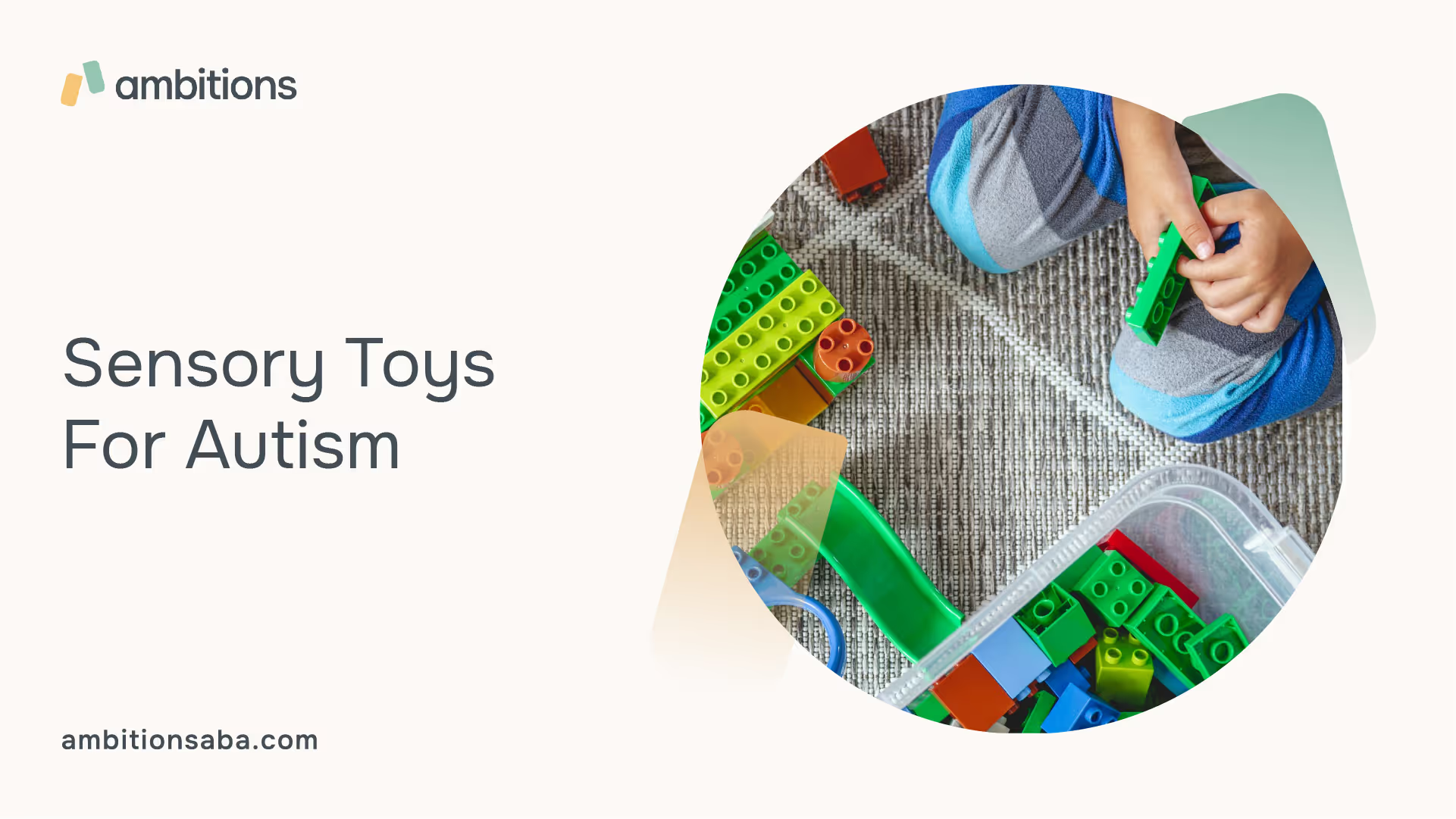Strategies for Supporting Neurodiverse Employees
Understanding Sensory Toys
Sensory toys play a vital role in supporting children with autism by providing them with the sensory experiences they desire and helping them engage with their senses. These toys are specially designed to stimulate one or more of the senses, creating a calming and engaging environment for children on the autism spectrum. Understanding the benefits of sensory toys and the sensory needs of children is crucial in choosing the right toys for their development and well-being.

Benefits of Sensory Toys
Sensory toys offer several benefits for children with autism. They provide a means for children to interact with their environment and engage with their senses, helping to stimulate their sensory systems and support their sensory integration. Some of the key benefits of sensory toys include:
Sensory Needs of Children
Children with autism often have unique sensory needs and sensitivities. Some may seek out certain sensory experiences, while others may be more sensitive to sensory input. Understanding a child's sensory profile is essential in selecting appropriate sensory toys. Common sensory needs of children with autism include:
By understanding the benefits of sensory toys and the specific sensory needs of children with autism, parents and caregivers can choose toys that provide an engaging and accessible play experience. It's important to select toys that match the child's interests, preferences, and developmental stage, ensuring a positive and enjoyable sensory play experience.
Types of Sensory Toys
Sensory toys play a crucial role in addressing the sensory needs of individuals with autism. These toys are specifically designed to provide various sensory inputs, stimulating different senses simultaneously and helping individuals explore and understand their environment in a meaningful way. Let's explore the four common types of sensory toys used for individuals with autism: tactile toys, visual stimulation toys, auditory toys, and proprioceptive and vestibular toys.
Tactile Toys
Tactile toys focus on the sense of touch, providing different textures and surfaces for children to explore. These toys can include items such as textured balls, squishy toys, fidget spinners, or sensory bins filled with materials like sand, rice, or water beads. Engaging with tactile toys helps develop sensory processing skills and enhances tactile awareness and discrimination.
Visual Stimulation Toys
Visual stimulation toys aim to stimulate and develop the sense of sight. These toys use vibrant colors, patterns, and movement to capture a child's attention and encourage visual exploration. Examples of visual stimulation toys include light-up toys, bubble tubes, spinning light projectors, and reflective balls. These toys are particularly beneficial for children with autism who may have difficulties processing visual sensory information.
Auditory Toys
Auditory toys focus on stimulating the sense of hearing. These toys produce different sounds and noises to engage children and encourage auditory exploration. Examples of auditory toys include musical instruments, sound puzzles, talking toys, and calming white noise machines. Auditory toys can help individuals with autism develop auditory discrimination skills and promote sensory integration.
Proprioceptive and Vestibular Toys
Proprioceptive and vestibular toys are designed to provide input to the body's proprioceptive and vestibular systems, which contribute to the sense of body position and movement. These toys help individuals with autism develop body awareness, balance, and coordination. Examples of proprioceptive and vestibular toys include swings, trampolines, rocking toys, and weighted blankets or vests. Engaging with these toys can have a calming effect and promote self-regulation.
By incorporating various sensory toys, individuals with autism can experience different sensory inputs and develop essential skills and abilities. Each type of sensory toy focuses on specific sensory areas, providing opportunities for sensory exploration and promoting overall well-being. It's important to observe and understand the preferences and responses of individuals with autism to ensure that the chosen sensory toys are beneficial and enjoyable for them.
Importance of Sensory Toys
Sensory toys play a crucial role in supporting the development and well-being of children with autism. These toys provide a range of benefits, including enhancing focus and attention, as well as promoting relaxation and calmness.
Enhancing Focus and Attention
Children with autism often face challenges in maintaining focus and attention. Sensory toys can help in this aspect by engaging multiple senses simultaneously. Sensory toys stimulate different senses such as touch, sight, and hearing. This stimulation helps children with autism explore and understand their environment in a meaningful way.
By incorporating sensory toys into their daily routine, children with autism can develop improved focus, attention, and self-regulation skills. The multisensory nature of these toys captures their interest and encourages sustained engagement, aiding in the development of important cognitive and social abilities.
Promoting Relaxation and Calmness
Managing sensory issues and promoting relaxation and calmness are essential aspects of supporting children with autism. Sensory toys provide a valuable tool in achieving these goals. According to the Carmen B. Pingree Center, sensory toys help children with autism relax, focus, and calm down in various scenarios or events.
These toys assist in decreasing fear and discomfort by enabling children to grasp objects with reduced anxiety. The tactile, visual, and auditory stimulation provided by sensory toys can have a soothing effect, helping children regulate their emotions and find comfort in their surroundings.
Moreover, sensory toys aid in the development of social learning skills, such as negotiating, planning, and sharing. By engaging with these toys, children with autism can practice important social behaviors in a safe and enjoyable context. This can have a positive impact on their interactions with peers and family members, fostering social development and inclusion.
In summary, sensory toys are valuable tools for children with autism. They enhance focus, attention, self-regulation, and communication skills, while also promoting relaxation, calmness, and social learning. By incorporating sensory toys into daily routines and playtime, parents and caregivers can provide meaningful support to children with autism, helping them thrive and reach their full potential.
Choosing the Right Sensory Toy
When it comes to selecting sensory toys for children with autism, it's important to consider their accessibility and engagement. The right sensory toy should enable children to interact with it in an accessible way, while also providing engaging play experiences.
Accessibility and Interaction
Toys appropriate and beneficial for children with autism are ones that enable them to engage in play with their family, friends, or peers and are designed so the child can interact with the toy in an accessible way [1]. Consider the following factors when choosing a sensory toy:
Engaging Play for Children
Engagement is a crucial aspect of sensory play for children with autism. The right sensory toy should provide opportunities for meaningful engagement and promote active participation. Consider the following when selecting toys:
By considering accessibility and interaction, you can choose sensory toys that are not only enjoyable but also beneficial for children with autism. Remember to involve the child in the selection process, taking into account their individual preferences and needs. Providing a range of sensory experiences through toys can contribute to their development and enhance their overall play experience.
DIY Sensory Toy Ideas
When it comes to providing sensory experiences for children with autism, DIY sensory toys can be a great way to engage their senses and promote their development. Here are a few ideas for homemade sensory toys that you can easily create at home:
Homemade Playdough
Making homemade playdough is a simple and versatile sensory activity that can provide hours of fun for children with autism. The squishy texture of playdough offers tactile stimulation and encourages fine motor skills development.
To make your own playdough, you'll need the following ingredients:
IngredientsMeasurementsAll-purpose flour2 cupsSalt1 cupCream of tartar2 tablespoonsVegetable oil2 tablespoonsWater1.5 cupsFood coloring (optional)A few drops
Mix the flour, salt, and cream of tartar in a saucepan. Add the vegetable oil and water, and stir until the mixture is smooth. Cook the mixture over low heat, stirring continuously, until it forms a ball of dough.
Once the playdough has cooled, you can add a few drops of food coloring to create vibrant colors. Allow the playdough to cool completely before giving it to your child. They can then explore, mold, and create to their heart's content.
Sensory Bottles
Sensory bottles are a fantastic DIY sensory toy that provides visual stimulation and relaxation. These bottles are filled with various materials that create captivating visual effects when shaken or rotated.
To make a sensory bottle, you'll need:
Fill the plastic bottle about three-quarters full with water. Add a few drops of clear glue or baby oil to create a slow-moving effect. Then, sprinkle in glitter or add small beads to enhance the visual appeal. Securely close the bottle with its cap, ensuring there are no leaks.
Your child can shake, rotate, and observe the mesmerizing movement of the objects suspended in the liquid. Sensory bottles can be particularly calming and soothing, providing a visual focus for children with autism.
Personalized Sensory Activities
Tailoring sensory activities to your child's interests and preferences can make them even more engaging. Consider incorporating their favorite objects into sensory play to create a personalized experience. For example:
By incorporating their interests into sensory activities, you can make the experience more enjoyable and meaningful for your child.
Engaging in these DIY sensory toy ideas can provide valuable sensory stimulation and promote various developmental skills for children with autism. The key is to experiment, observe your child's reactions, and adapt the activities to their specific needs and interests. Remember, engaging in sensory activities with toys can have positive benefits for children, not limited to those diagnosed with autism.
References
[2]:
[3]:
[4]:

